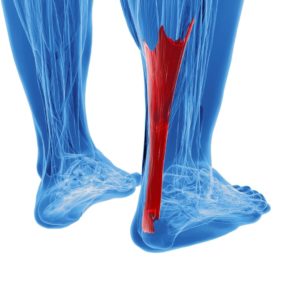Calf pain?
All you need to know about Achilles Tendinosis
Calf Pain? Here’s What You Need to Know About Achilles Tendinosis
It’s Sunday, and you’re lacing up your boots for a friendly game with your soccer team. After years of taking a break from the sport, you’ve decided to get back into it. Life has been kind—your partner, kids, and even your waistline have all grown with you over the years. But now, midway through the season, that old calf injury is flaring up again. It’s a familiar ache, one you haven’t felt in years, but it’s back. Why now?
What Causes Achilles Tendinosis?
This scenario is more common than you might think, especially for people returning to sports after time off. We’re thrilled when people get back into an active lifestyle, but sometimes that means dealing with old injuries, like Achilles tendinosis.
The Achilles tendon is a large, powerful tendon at the back of the ankle. It connects the calf muscles (gastrocnemius and soleus) to the heel bone (calcaneus). This tendon acts as a spring, helping us push off when we walk or run. However, repeated stress can cause the tendon fibers to break down and become disorganized, resulting in tendinosis.
This condition is especially common in middle-aged individuals, often those carrying extra weight. It typically affects the mid-portion of the tendon, where it connects to the calf. For our soccer player, this might be the culprit.
Symptoms of Achilles Tendinosis
The main symptom is pain, especially when moving after long periods of rest. Initially, the pain may subside as you continue to move, but it often returns once you stop. Swelling around the tendon insertion can also occur. Activities like climbing stairs, hopping, or any movement that puts load on the tendon may cause discomfort.
How Can You Treat Achilles Tendinosis?
If you’re dealing with Achilles tendinosis, you’re in the right place. As osteopaths, we regularly treat this condition and can guide you through recovery. The first step is a thorough assessment, which includes asking questions and observing your movement patterns.
Often, tendon pain is linked to old injuries that weren’t fully rehabilitated. Or, it could stem from issues with current movement patterns and muscle weakness. Our goal is to eliminate pain and restore function, so you can stay active longer.
The Importance of Strength Training
Strength training plays a crucial role in recovering from Achilles tendinosis. One key exercise we often recommend is the heel raise. This involves slowly lowering yourself off the edge of a step, allowing the tendon to stretch while the muscle lengthens. This technique helps reorganize the fibers within the tendon, making it stronger and more efficient.
While heel raises are an essential part of the rehabilitation process, your recovery plan will involve more. You may need exercises to strengthen your feet, hamstrings, glutes, and core. Additionally, ankle mobility exercises can help improve function. In some cases, orthotics may be necessary to provide extra support.
Don’t Wait—Start Your Recovery Now
It’s crucial not to wait for the pain to magically disappear. The sooner you seek treatment, the sooner you can start healing. Our osteopaths are here to guide you through the process step by step, ensuring a safe and speedy recovery.
So, if your calf pain is holding you back, give us a call. We’ll help you get back on your feet—and back on the field—in no time!
References:
- Li, H. and Hua, Y. 2016. Achilles Tendinopathy: Current Concepts about the Basic Science and Clinical Treatments. BioMed Research International, 1-9. Link
- Sports Medicine Australia. 2019. Achilles Tendon Injuries. Available from: Link
- Brukner, P. et al. 2017. Clinical Sports Medicine (5th ed.). Australia: McGraw-Hill Education.
- Aicale R., Tarantino D., Maffulli N. (2019) Non-insertional Achilles Tendinopathy: State of the Art. In: Canata G., d’Hooghe P., Hunt K., Kerkhoffs G., Longo U. (eds) Sports Injuries of the Foot and Ankle. Springer.
- Karlsson J., Brorsson A., Jónsdóttir U., Silbernagel K.G. (2019) Treatment of Achilles Tendinopathies. In: Rocha Piedade S., Imhoff A., Clatworthy M., Cohen M., Espregueira-Mendes J. (eds) The Sports Medicine Physician. Springer.

